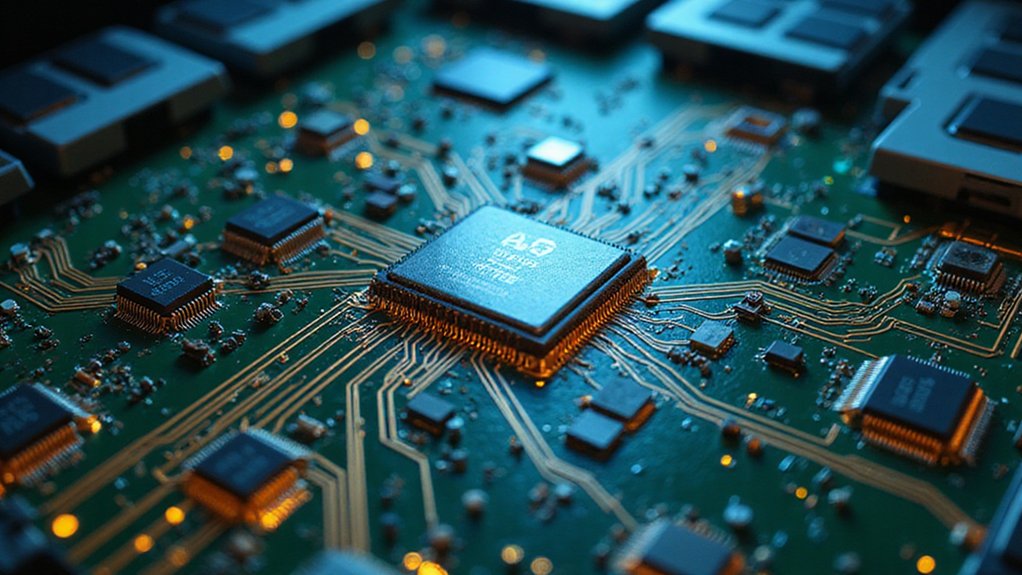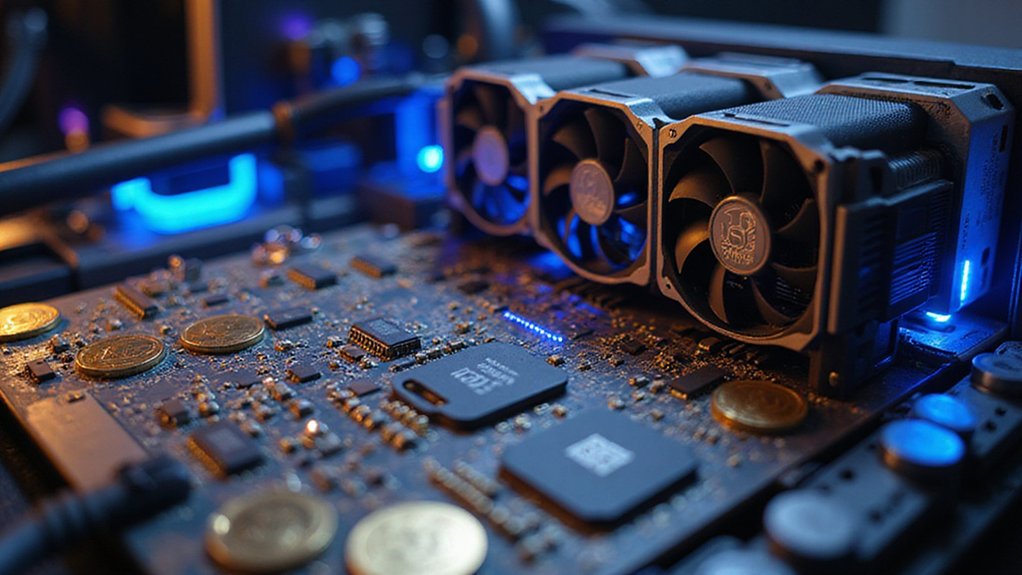Proof of Work transforms Bitcoin mining into an elaborate—and expensive—guessing game where miners compete to solve cryptographic puzzles using SHA-256 algorithms, burning electricity to validate transactions and secure the network. This consensus mechanism cleverly aligns economic incentives with network security, making malicious attacks prohibitively costly while maintaining a trustless, decentralized ledger that operates without central authority. The system’s self-regulating difficulty adjustments guarantee consistent 10-minute block times, though environmental concerns spark ongoing debates about its sustainability and future viability.

While Bitcoin’s meteoric rise has captured headlines and spawned countless get-rich-quick schemes, the underlying mechanism that secures the world’s first cryptocurrency—Proof of Work—remains as misunderstood as it is computationally elegant.
At its core, Proof of Work functions as a consensus mechanism that transforms electricity into trust—a peculiar alchemy that would make medieval alchemists weep with envy. The system requires miners to expend computational resources solving cryptographic puzzles, creating an economic incentive structure where network security becomes profitable rather than altruistic.
A peculiar alchemy that transforms electricity into trust, making network security profitable rather than altruistic through computational expense.
These decentralized nodes compete to validate transactions by generating hashes that meet specific difficulty thresholds, fundamentally playing an expensive guessing game with SHA-256 algorithms.
The beauty (and environmental nightmare) lies in the self-regulating difficulty adjustment that occurs approximately every two weeks. As more miners join the network, the computational challenge increases to maintain Bitcoin’s sacred 10-minute block time—a feature that guarantees consistency while consuming enough energy to power small nations.
This dynamic calibration prevents the blockchain from becoming either too easy to manipulate or impossibly slow to process transactions.
Security emerges from sheer computational expense. Altering any historical transaction would require re-mining all subsequent blocks, a feat demanding majority network control and resources that would make most nation-states balk.
The system’s genius lies in making honest behavior more profitable than malicious activity—assuming, of course, that miners can afford the specialized hardware and electricity bills that would humble most industrial operations.
The economic implications are staggering. Mining operations must balance reward potential against operational costs, creating a delicate equilibrium where profitability determines network participation. Bitcoin’s current mining reward of 3.125 BTC undergoes halving every four years, fundamentally altering the economic landscape for miners worldwide.
This perpetual arms race drives hardware innovation while simultaneously raising environmental concerns that have sparked regulatory scrutiny worldwide. Texas lawmakers recently passed registration requirements for mining facilities, requiring annual disclosure of facility information including location, owners, and electricity demand.
Critics rightfully question whether consuming Iceland’s annual electricity output to secure digital transactions represents progress or madness.
Yet Proof of Work continues delivering what traditional financial systems struggle to achieve: a trustless, decentralized ledger that operates without central authority, converting raw computational power into immutable financial truth. This approach contrasts sharply with decentralized finance systems that eliminate intermediaries to enable direct peer-to-peer transactions across various blockchain platforms.
Whether this represents humanity’s financial future or an elaborate exercise in distributed inefficiency remains hotly debated among economists, environmentalists, and those brave enough to pay mining electricity bills.
Frequently Asked Questions
What Are the Main Alternatives to Proof of Work Consensus Mechanisms?
The primary alternatives to proof-of-work include Proof of Stake (PoS), where validators are selected based on their token holdings rather than computational power;
Delegated Proof of Stake (DPoS), which introduces democratic voting for validator selection;
Proof of Authority (PoA), relying on pre-approved, trusted validators;
and Practical Byzantine Fault Tolerance (PBFT), designed for permissioned networks requiring rapid consensus despite potential malicious actors.
How Much Electricity Does Bitcoin’s Proof of Work Actually Consume Annually?
Bitcoin’s proof-of-work mechanism consumes approximately 112 terawatt-hours annually—equivalent to Kazakhstan’s entire electricity consumption.
This figure, derived from Cambridge’s Bitcoin Electricity Consumption Index, represents a staggering energy appetite that dwarfs many nations’ total usage.
Each transaction requires roughly 57 days’ worth of average American household electricity, translating to over 500 miles of gasoline-powered driving per transaction—a rather inconvenient truth for digital currency enthusiasts.
Can Proof of Work Be Made More Environmentally Friendly Without Compromising Security?
Proof of Work can indeed become more environmentally friendly through several mechanisms while preserving security integrity.
Mining operations increasingly integrate renewable energy sources, reducing carbon footprints substantially. Enhanced ASIC efficiency delivers more computational power per watt consumed.
Layer 2 solutions minimize on-chain transactions requiring energy-intensive validation. Hybrid consensus models strategically combine PoW with alternative mechanisms.
However, achieving complete environmental sustainability remains challenging given PoW’s inherently energy-intensive nature—though progress continues steadily.
Which Cryptocurrencies Besides Bitcoin Currently Use Proof of Work?
Several cryptocurrencies maintain proof-of-work consensus beyond Bitcoin’s dominance.
Bitcoin Cash and Bitcoin SV employ SHA-256 (like their predecessor), while Litecoin and Dogecoin utilize Scrypt algorithms.
Ethereum Classic retained PoW after Ethereum’s changeover, using Ethash.
Privacy-focused coins like Monero (RandomX) and Zcash (Equihash) employ specialized algorithms, with Monero optimizing for CPU mining.
Dash rounds out the field with X11—each demonstrating that computational consensus remains surprisingly resilient despite environmental criticisms.
How Long Does It Typically Take to Mine One Block?
Bitcoin’s network targets a remarkably precise ten-minute block interval, maintained through algorithmic difficulty adjustments every 2,016 blocks.
While individual miners wielding typical ASIC hardware might wait years to solo-mine a single block (given their microscopic hash rate fraction), the network’s collective 600+ exahash-per-second computational power consistently delivers blocks near this ten-minute target—though probabilistic mining occasionally produces outliers exceeding an hour.









